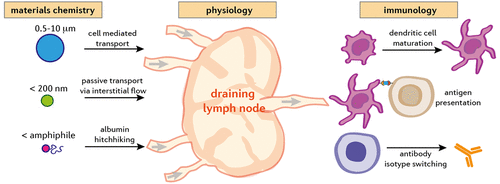当前位置:
X-MOL 学术
›
Acc. Chem. Res.
›
论文详情
Our official English website, www.x-mol.net, welcomes your
feedback! (Note: you will need to create a separate account there.)
Engineering Strategies for Lymph Node Targeted Immune Activation.
Accounts of Chemical Research ( IF 16.4 ) Pub Date : 2020-09-10 , DOI: 10.1021/acs.accounts.0c00260 Yong Chen 1 , Stefaan De Koker 2 , Bruno G De Geest 1
Accounts of Chemical Research ( IF 16.4 ) Pub Date : 2020-09-10 , DOI: 10.1021/acs.accounts.0c00260 Yong Chen 1 , Stefaan De Koker 2 , Bruno G De Geest 1
Affiliation

|
Development of vaccine technology that induces long lasting and potent adaptive immune responses is of vital importance to combat emerging pathogens and to design the next generation of cancer immunotherapies. Advanced biomaterials such as nanoparticle carriers are intensively explored to increase the efficacy and safety of vaccines and immunotherapies, based on their intrinsic potential to focus the therapeutic payload onto the relevant immune cells and to limit systemic distribution. With adaptive immune responses being primarily initiated in lymph nodes, the potency of nanoparticle vaccines in turn is tightly linked to their capacity to reach and accumulate in the lymph nodes draining the immunization site. Here, we discuss the main strategies applied to increase nanoparticle delivery to lymph nodes: (1) direct lymph node injection, (2) active cell-mediated transport through targeting of peripheral dendritic cells, and (3) exploiting passive transport through the afferent lymphatics.
中文翻译:

淋巴结靶向免疫激活的工程策略。
诱导持久和有效的适应性免疫应答的疫苗技术的发展对于对抗新兴病原体和设计下一代癌症免疫疗法至关重要。基于先进的生物材料(如纳米颗粒载体)的内在潜力,其将治疗有效载荷集中在相关免疫细胞上并限制全身分布的内在潜力,因此正在对其进行深入研究以提高疫苗和免疫疗法的功效和安全性。随着适应性免疫反应主要在淋巴结中启动,纳米疫苗的效力又与它们达到并积累排空免疫部位的淋巴结的能力紧密相关。在这里,我们讨论了用于增加纳米颗粒向淋巴结递送的主要策略:(1)直接淋巴结注射,
更新日期:2020-10-21
中文翻译:

淋巴结靶向免疫激活的工程策略。
诱导持久和有效的适应性免疫应答的疫苗技术的发展对于对抗新兴病原体和设计下一代癌症免疫疗法至关重要。基于先进的生物材料(如纳米颗粒载体)的内在潜力,其将治疗有效载荷集中在相关免疫细胞上并限制全身分布的内在潜力,因此正在对其进行深入研究以提高疫苗和免疫疗法的功效和安全性。随着适应性免疫反应主要在淋巴结中启动,纳米疫苗的效力又与它们达到并积累排空免疫部位的淋巴结的能力紧密相关。在这里,我们讨论了用于增加纳米颗粒向淋巴结递送的主要策略:(1)直接淋巴结注射,











































 京公网安备 11010802027423号
京公网安备 11010802027423号